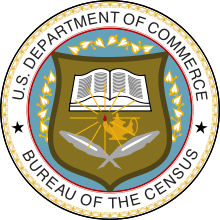1820 United States Census
The United States Census of 1820 was the fourth Census conducted in the United States. It was conducted on August 7, 1820. The 1820 Census included six new states: Louisiana, Indiana, Mississippi, Illinois, Alabama and Maine. There has been a district wide loss of 1820 Census records for Arkansas Territory, Missouri Territory and New Jersey, however.
The total population was determined to be 9,638,453, of which 1,538,022 were slaves. The center of population was about 120 miles (193 km) west-northwest of Washington in Hardy County, Virginia (now in West Virginia).
Data Collected
The 1820 census contains a great deal more information than previous censuses. Enumerators listed the following data in columns, left to right:
- Name of the head of family
- # of free white males under age 10
- # of free white males age 10-16
- # of free white males age 16-18
- # of free white males age 16-26
- # of free white males age 26-45
- # of free white males age 45 and up
- # of free white females under age 10
- # of free white females age 10-16
- # of free white females age 16-26
- # of free white females age 26-45
- # of free white females age 45 and up
- # of foreigners not naturalized
- # of persons engaged in agriculture
- # of persons engaged in commerce
- # of persons engaged in manufacture
- # of male slaves under 14
- # of male slaves age 14-26
- # of male slaves age 26-45
- # of male slaves age 45 and up
- # of female slaves under 14
- # of female slaves age 14-26
- # of female slaves age 26-45
- # of female slaves age 45 and up
- # of free male colored persons under 14
- # of free male colored persons age 14-26
- # of free male colored persons age 26-45
- # of free male colored persons age 45 and up
- # of free female colored persons under 14
- # of free female colored persons age 14-26
- # of free female colored persons age 26-45
- # of free female colored persons age 45 and up
- # of all other persons except Indians not taxed
Several of these columns were for special counts, and not to be included in the aggregate total. Doing so would have resulted in counting some individuals twice. Census takers were asked to use double lines, red ink or some other method of distinguishing these columns so that double counting would not occur. For example, the count of free white males between 16 and 18 was a special count, because these individuals were also supposed to be tabulated in the column for free white males of age 16 and under 26.
The other special counts were foreigners not naturalized, persons engaged in agriculture, persons engaged in commerce, and persons engaged in manufacture.
Census takers were also instructed to count each individual in only one of the occupational columns. For example, if an individual was engaged in agriculture, commerce, and manufacture, the census taker had to judge which one the individual was primarily engaged in.
Note to Researchers
Censustaking was not yet an exact science. Before 1830, enumerators lacked pre-printed forms, and drew up their own, sometimes resulting in pages without headings, line tallies, or column totals. As a result, census records for many towns before 1830 are idiosyncratic. This is not to suggest that they are less reliable than subsequent censuses, but that they may require more work on the part of the researcher.
Further reading
| |||||||||||||
